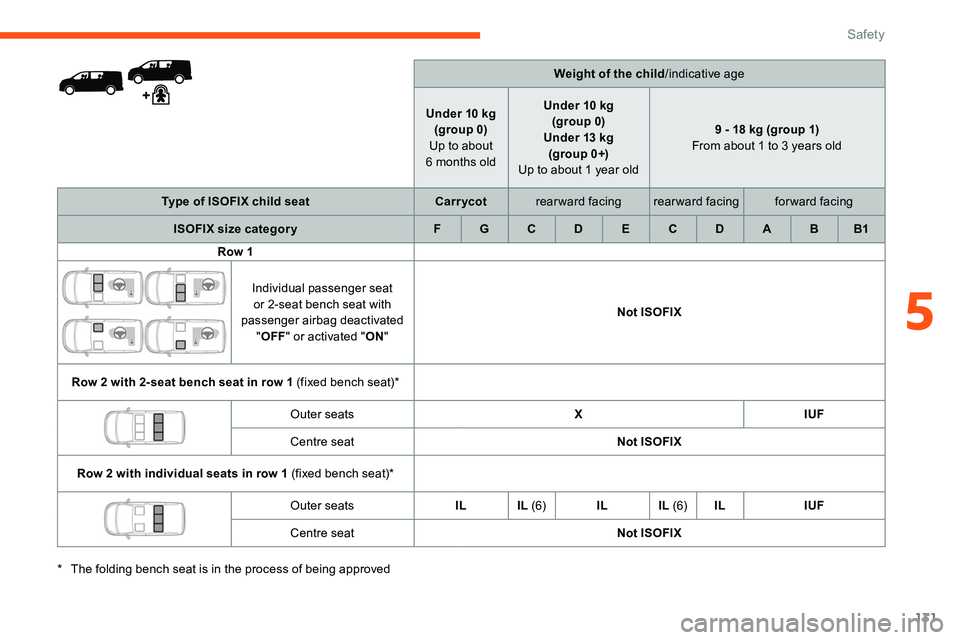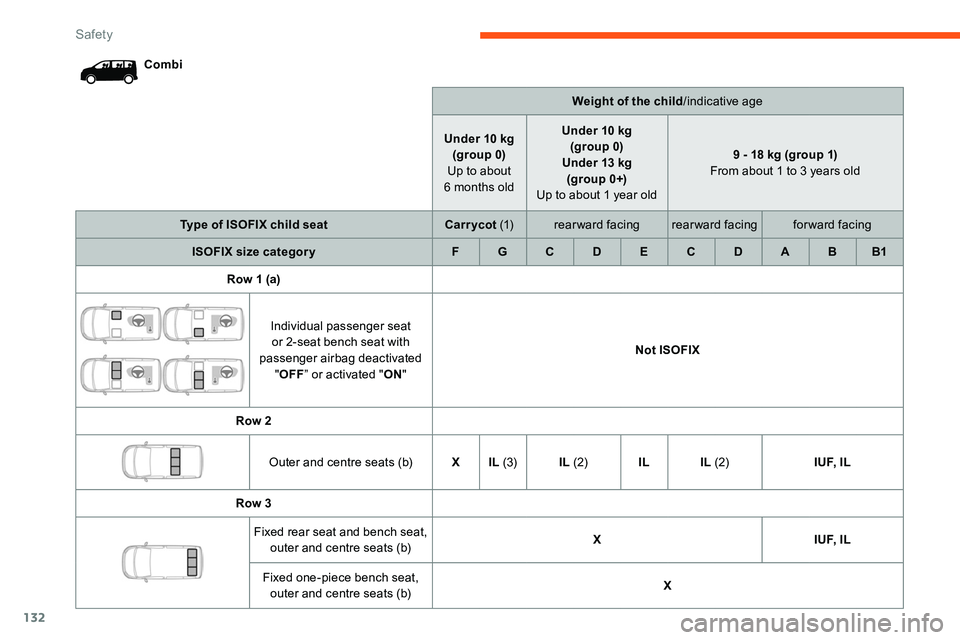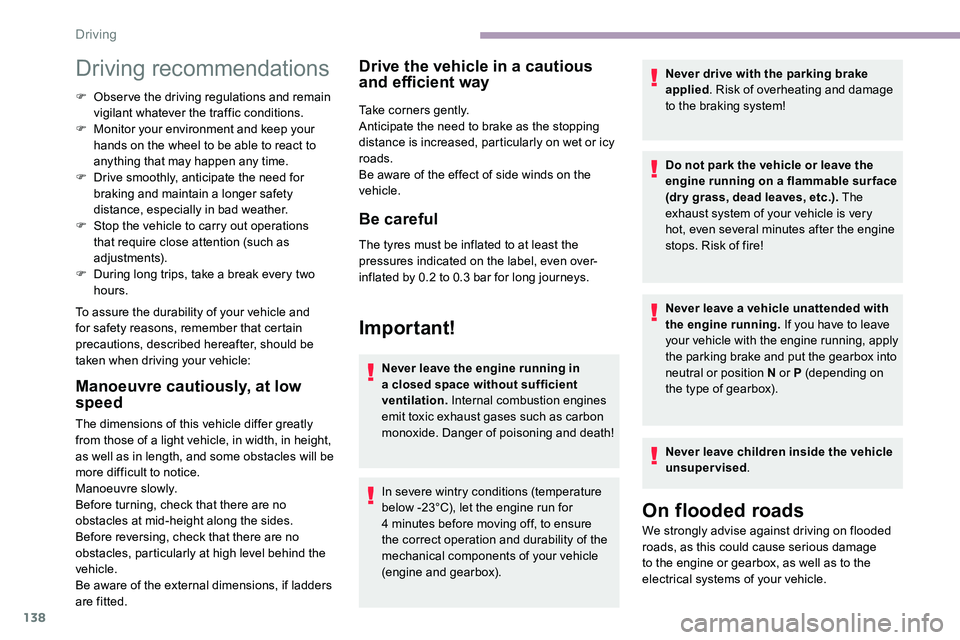CITROEN DISPATCH SPACETOURER DAG 2020 Handbook (in English)
Manufacturer: CITROEN, Model Year: 2020, Model line: DISPATCH SPACETOURER DAG, Model: CITROEN DISPATCH SPACETOURER DAG 2020Pages: 324, PDF Size: 10.89 MB
Page 131 of 324

129
UFSeat position suitable for the installation
of a child seat secured using the seat belt
and universally approved "forward facing".
X Seat position not suitable for the
installation of a child seat of the weight
class indicated.
"ISOFIX" mountingsThe vehicle has been approved in accordance
with the latest ISOFIX regulation.
If fitted to the vehicle, the ISOFIX regulation
mountings are identified by labels.
The mountings comprise three rings for each
seat:
-
T
wo front rings A , located between the
vehicle seat backrest and cushion, indicated
by an "ISOFIX" marking,
-
I
f fitted to your vehicle, a rear ring B called
the Top Tether and located behind the
vehicle's seat, for securing the upper strap,
as indicated by a "Top Tether" marking.
The Top Tether is used to secure the upper
strap of child seats that have one. This system
prevents the child seat from tipping for ward in
the event of a front impact.
This ISOFIX mounting system provides fast,
reliable and safe fitting of the child seat in your
vehicle. For information on the possibilities for
installing ISOFIX child seats in your
vehicle, refer to the summary table.
The ISOFIX child seats are fitted with two
latches which are secured on the two front
rings A
.
Some child seats also have an upper strap
which is attached to rear ring B .
To secure the child seat to the Top Tether:
-
r
emove and stow the head restraint before
installing a child seat on this seat (refit it
once the child seat has been removed),
-
r
un the strap of the child seat behind the top
of the seat backrest, centring it between the
holes for the head restraint rods,
-
a
ttach the hook of the upper strap to rear
ring B ,
-
t
ighten the upper strap.
The incorrect installation of a child seat in
a vehicle compromises the protection of
the child in the event of an accident.
Strictly follow the fitting instructions
provided in the installation guide supplied
with the child seat.
5
Safety
Page 132 of 324

130
Recommended ISOFIX
child seats
Also consult the user guides from the child
seat’s manufacturer to find out how to
install and remove the seat.
Locations for ISOFIX child
seats
In accordance with European regulations, the
table indicates the options for installing ISOFIX
child seats on the vehicle seats fitted with
ISOFIX mountings.
In the case of universal and semi-universal
ISOFIX child seats, the ISOFIX size category,
determined by a letter from A to G, is indicated
on the child seat next to the ISOFIX logo.
"RÖMER Baby- Safe Plus and its ISOFIX
base"
(size category: E )
Group 0+: from bir th to 13
kg
Installed rearward facing using an ISOFIX base which is attached to rings A .
The base has a support leg, height-
adjustable, which rests on the vehicle's floor. This child seat can also be secured with a
seat belt. In this case, only the shell is used and attached to the vehicle seat using the three-point seat belt. "
RÖMER Duo Plus ISOFIX "
(size category: B1 )
Group 1: from 9 to 18kg
Installed only in the forward facing position.
Is attached to rings A and ring B , referred to
as TOP TETHER, using an upper strap.
Three seat body angles: sitting, reclining, lying down.
This child seat can also be used on seats not equipped with ISOFIX mountings. In
this case, it must be secured to the vehicle's seat by the three-point seat belt. Adjust the
position of the vehicle's front seat so that the child's feet are not touching the backrest.
Safety
Page 133 of 324

131
Weight of the child/indicative age
Under 10
kg
(group 0)
Up to about
6
months old Under 10
kg
(group 0)
Under 13
kg
(group 0+)
Up to about 1 year old 9 - 18
kg (group 1)
From about 1 to 3 years old
Type of ISOFIX child seat Carr ycotrearward facing rearward facing forward facing
ISOFIX size categor y F G C D E C D A B B1
Row 1
Individual passenger seat or 2-seat bench seat with
passenger airbag deactivated "OFF " or activated " ON" Not ISOFIX
Row 2 with 2-seat bench seat in row 1 (fixed bench seat)* Outer seats XIUF
Centre seat Not ISOFIX
Row 2 with individual seats in row 1 (fixed bench seat)* Outer seatsIL IL (6)IL IL (6)IL IUF
Centre seat Not ISOFIX
*
T
he folding bench seat is in the process of being approved
5
Safety
Page 134 of 324

132
CombiWeight of the child/indicative age
Under 10
kg
(group 0)
Up to about
6
months oldUnder 10
kg
(group 0)
Under 13
kg
(group 0+)
Up to about 1 year old 9 - 18
kg (group 1)
From about 1 to 3 years old
Type of ISOFIX child seat Carr ycot (1) rearward facing rearward facing forward facing
ISOFIX size categor y F G C D E C D A B B1
Row 1 (a)
Individual passenger seat or 2-seat bench seat with
passenger airbag deactivated "OFF ” or activated " ON" Not ISOFIX
Row 2 Outer and centre seats (b) XIL (3) IL (2) IL IL (2) I U F, I L
Row 3 Fixed rear seat and bench seat, outer and centre seats (b) X
I U F, I L
Fixed one-piece bench seat, outer and centre seats (b) X
Safety
Page 135 of 324

133
BusinessWeight of the child/indicative age
Under 10
kg
(group 0)
Up to about
6
months oldUnder 10
kg
(group 0)
Under 13
kg
(group 0+)
Up to about 1 year old 9 - 18
kg (group 1)
From about 1 to 3 years old
Type of ISOFIX child seat Carr ycot (1) rearward facing rearward facing forward facing
ISOFIX size categor y F G C D E C D A B B1
Row 1 (a)
Individual passenger seat or 2-seat bench seat with
passenger airbag deactivated "OFF " or activated " ON" Not ISOFIX
Row 2 Rear seats XIL
(1- 3) IL
(2) IL IL (2) I U F, I L
Row 3 Fixed rear seat and bench seat, rear seats X
I U F, I L
Fixed one-piece bench seat, rear seats X
5
Safety
Page 136 of 324

134
FeelWeight of the child/indicative age
Under 10
kg
(group 0)
Up to about
6
months oldUnder 10
kg
(group 0)
Under 13
kg
(group 0+)
Up to about 1 year old From 9 to 18
kg (group 1)
From about 1 to 3 years old
Type of ISOFIX child seat Carr ycot (1) rearward facing rearward facing forward facing
ISOFIX size categor y F G C D E C D A B B1
Row 1 (a)
Passenger seat with passenger airbag deactivated " OFF" or
activated " ON" Not ISOFIX
Row 2 Rear seats ILI U F, I L
Row 3 Rear seats IL (1- 4) XIL (4) XIL (4) I U F, I L
Safety
Page 137 of 324

135
Shine, Business Lounge
Weight of the child/indicative age
Under 10
kg
(group 0)
Up to about
6 months old Under 10
kg
(group 0)
Under 13
kg
(group 0+)
Up to about 1 year old 9 - 18
kg (group 1)
From about 1 to 3 years old
Type of ISOFIX child seat Carr ycot (1) rearward facing
rearward facingforward facing
ISOFIX size categor y F G C D E C D A B B1
Row 1 (a) Passenger seat with passenger airbag deactivated " OFF" or
activated " ON" Not ISOFIX
Row 2 Seat behind driver or passenger X
IL(5) IL IL (5)IL I U F, I L
Centre seat (b) XIL(5) IL IL (5)IL I U F, I L
Rear seats IL (1- 5) ILILI U F, I L
Row 3 Outer seats XIL (4) IL IL (4) I U F, I L
Centre seat (b) XIL (4) IL IL (4) I U F, I L
Rear seats IL (1- 4) XIL (4) XIL (4) I U F, I L
5
Safety
Page 138 of 324

136
(a)Refer to the current legislation in the
country where you are driving, before
installing a child at this seat position.
(b) The seat can be installed centrally in the
vehicle
; it then prevents the use of the
outer seats.
IUF Seat position suitable for installing an
Isofix U niversal seat, " For ward facing",
secured using the upper strap.
IL Seat position suitable for installing an
Isofix semi-universa L child seat which
can be:
-
"
rear ward facing" fitted with an upper
strap or a support leg,
-
"
for ward facing" fitted with a support leg,
-
a c
arrycot fitted with an upper strap or
a support leg.
For securing the upper strap using
the ISOFIX mountings , refer to the
corresponding section.
X Seat position unsuitable for the installation
of an ISOFIX child seat or carrycot of the
weight group indicated. (4)
The seat in row 2 must be adjusted so that
there is no contact between the child in
row 3 and the seat immediately in front.
(5) The front seat must be adjusted so that
there is no contact between the child in
row 2 and the seat immediately in front.
(6) The front seat must be adjusted so that
there is no contact between the child in
row 2 and the seat immediately in front
(with the front seat adjusted to 2 notches
ahead of the centre of the runner).
(1) The installation of a carrycot on this seat
may prevent the use of one or more of the
other seats in this row.
(2) Installation possible only behind the
driver's seat.
(3) Installation possible only behind the
driver's seat with individual passenger
seat.
Manual child lock
Mechanical system to prevent opening of the
sliding side door using its interior lever.
Locking/Unlocking
F Turn the control located on the edge of the
side door upwards to lock it or downwards
to unlock it.
Electric child lock
Remote control system to prevent
opening of the rear doors (sliding
side door(s), side-hinged doors or
tailgate (depending on version))
using their interior controls.
Activation/Deactivation
With the ignition on:
F
P
ress this button ; its indicator remains on
for as long as the child lock is activated. A
message confirms the activation.
It is still possible to open the doors from the
outside.
Safety
Page 139 of 324

137
F Press this button again ; its indicator
remains off for as long as the child lock
is deactivated. A message confirms the
deactivation.
In the event of a serious impact, the
electric child lock is deactivated (child lock
off) automatically.
Any other state of the indicator lamp
indicates a fault with the electric child lock.
Have it checked by a CITROËN dealer or
a qualified workshop.
This system is independent and in no
circumstances does it take the place of
the central locking control.
Do not drive with the sliding side door
open.
Check the status of the child lock each
time you switch on the ignition.
Always remove the key from the ignition
when leaving the vehicle, even for a short
time.Child lock on rear
windows
This mechanical system prevents
opening of the left and/or right rear
side windows.
F
L
ock /unlock the system using the remote
control key or the back-up key of the
Keyless Entry and Starting system.
5
Safety
Page 140 of 324

138
Driving recommendations
F Observe the driving regulations and remain vigilant whatever the traffic conditions.
F
M
onitor your environment and keep your
hands on the wheel to be able to react to
anything that may happen any time.
F
D
rive smoothly, anticipate the need for
braking and maintain a longer safety
distance, especially in bad weather.
F
S
top the vehicle to carry out operations
that require close attention (such as
adjustments).
F
D
uring long trips, take a break every two
hours.
To assure the durability of your vehicle and
for safety reasons, remember that certain
precautions, described hereafter, should be
taken when driving your vehicle:
Manoeuvre cautiously, at low
speed
The dimensions of this vehicle differ greatly
from those of a light vehicle, in width, in height,
as well as in length, and some obstacles will be
more difficult to notice.
Manoeuvre slowly.
Before turning, check that there are no
obstacles at mid-height along the sides.
Before reversing, check that there are no
obstacles, particularly at high level behind the
vehicle.
Be aware of the external dimensions, if ladders
are fitted.
Drive the vehicle in a cautious
and efficient way
Take corners gently.
Anticipate the need to brake as the stopping
distance is increased, particularly on wet or icy
roads.
Be aware of the effect of side winds on the
vehicle.
Be careful
The tyres must be inflated to at least the
pressures indicated on the label, even over-
inflated by 0.2 to 0.3 bar for long journeys.
Important!
Never leave the engine running in
a closed space without sufficient
ventilation. Internal combustion engines
emit toxic exhaust gases such as carbon
monoxide. Danger of poisoning and death!
In severe wintry conditions (temperature
below -23°C), let the engine run for
4
minutes before moving off, to ensure
the correct operation and durability of the
mechanical components of your vehicle
(engine and gearbox). Never drive with the parking brake
applied
. Risk of overheating and damage
to the braking system!
Do not park the vehicle or leave the
engine running on a flammable sur face
(dr y grass, dead leaves, etc.). The
exhaust system of your vehicle is very
hot, even several minutes after the engine
stops. Risk of fire!
Never leave a vehicle unattended with
the engine running. If you have to leave
your vehicle with the engine running, apply
the parking brake and put the gearbox into
neutral or position N or P (depending on
the type of gearbox).
Never leave children inside the vehicle
unsupervised .
On flooded roads
We strongly advise against driving on flooded
roads, as this could cause serious damage
to the engine or gearbox, as well as to the
electrical systems of your vehicle.
Driving